Entrepreneurial Dilemmas Essay
VerifiedAdded on 2019/10/08
|14
|4125
|337
Essay
AI Summary
This essay analyzes the entrepreneurial journey of Sabeer Bhatia, founder of Hotmail, using Noam Wasserman's framework. It examines key dilemmas faced by Bhatia, including pre-founding challenges, developing a billion-dollar business plan, managing team dynamics, and understanding rew...

Name
College
1
College
1
Paraphrase This Document
Need a fresh take? Get an instant paraphrase of this document with our AI Paraphraser

Contents
Part A...........................................................................................................................................................3
Introduction.............................................................................................................................................3
A positive outlook at the dilemmas of career took him to the new height.............................................4
As a startup owner, one has to check the equations of the Pre-founding...............................................5
The Billon Dollar business plan to cover the entire business operations.................................................6
Handling Team Dynamism is an important task......................................................................................7
Think of a reward in the terms of your input...........................................................................................8
Findings on a conclusive note..................................................................................................................9
Part B.........................................................................................................................................................10
My Journey in the current Module........................................................................................................10
It should be out of the Box, however, it should be inside the room..................................................10
How I see myself as CEO a big stake company or a smaller unit........................................................10
My Choice as a Solo or Team founder...............................................................................................11
My experience in the game of Co-founding.......................................................................................11
My position on the founder’s card....................................................................................................11
Discovery and vision Card..................................................................................................................12
Core Concepts and the Set of Skills should play like a symphony......................................................12
Conclusion of the reflection...............................................................................................................12
References.................................................................................................................................................13
2
Part A...........................................................................................................................................................3
Introduction.............................................................................................................................................3
A positive outlook at the dilemmas of career took him to the new height.............................................4
As a startup owner, one has to check the equations of the Pre-founding...............................................5
The Billon Dollar business plan to cover the entire business operations.................................................6
Handling Team Dynamism is an important task......................................................................................7
Think of a reward in the terms of your input...........................................................................................8
Findings on a conclusive note..................................................................................................................9
Part B.........................................................................................................................................................10
My Journey in the current Module........................................................................................................10
It should be out of the Box, however, it should be inside the room..................................................10
How I see myself as CEO a big stake company or a smaller unit........................................................10
My Choice as a Solo or Team founder...............................................................................................11
My experience in the game of Co-founding.......................................................................................11
My position on the founder’s card....................................................................................................11
Discovery and vision Card..................................................................................................................12
Core Concepts and the Set of Skills should play like a symphony......................................................12
Conclusion of the reflection...............................................................................................................12
References.................................................................................................................................................13
2
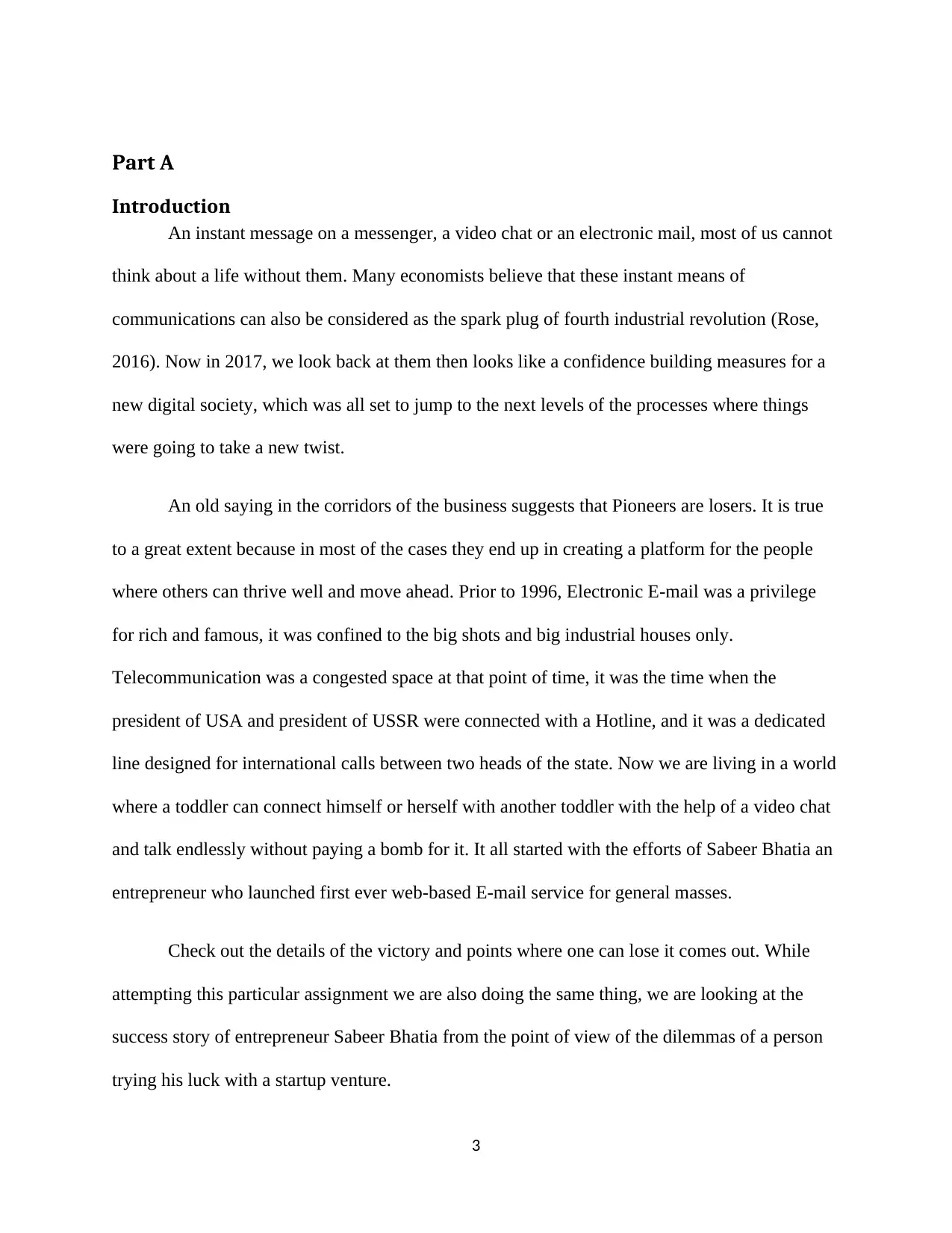
Part A
Introduction
An instant message on a messenger, a video chat or an electronic mail, most of us cannot
think about a life without them. Many economists believe that these instant means of
communications can also be considered as the spark plug of fourth industrial revolution (Rose,
2016). Now in 2017, we look back at them then looks like a confidence building measures for a
new digital society, which was all set to jump to the next levels of the processes where things
were going to take a new twist.
An old saying in the corridors of the business suggests that Pioneers are losers. It is true
to a great extent because in most of the cases they end up in creating a platform for the people
where others can thrive well and move ahead. Prior to 1996, Electronic E-mail was a privilege
for rich and famous, it was confined to the big shots and big industrial houses only.
Telecommunication was a congested space at that point of time, it was the time when the
president of USA and president of USSR were connected with a Hotline, and it was a dedicated
line designed for international calls between two heads of the state. Now we are living in a world
where a toddler can connect himself or herself with another toddler with the help of a video chat
and talk endlessly without paying a bomb for it. It all started with the efforts of Sabeer Bhatia an
entrepreneur who launched first ever web-based E-mail service for general masses.
Check out the details of the victory and points where one can lose it comes out. While
attempting this particular assignment we are also doing the same thing, we are looking at the
success story of entrepreneur Sabeer Bhatia from the point of view of the dilemmas of a person
trying his luck with a startup venture.
3
Introduction
An instant message on a messenger, a video chat or an electronic mail, most of us cannot
think about a life without them. Many economists believe that these instant means of
communications can also be considered as the spark plug of fourth industrial revolution (Rose,
2016). Now in 2017, we look back at them then looks like a confidence building measures for a
new digital society, which was all set to jump to the next levels of the processes where things
were going to take a new twist.
An old saying in the corridors of the business suggests that Pioneers are losers. It is true
to a great extent because in most of the cases they end up in creating a platform for the people
where others can thrive well and move ahead. Prior to 1996, Electronic E-mail was a privilege
for rich and famous, it was confined to the big shots and big industrial houses only.
Telecommunication was a congested space at that point of time, it was the time when the
president of USA and president of USSR were connected with a Hotline, and it was a dedicated
line designed for international calls between two heads of the state. Now we are living in a world
where a toddler can connect himself or herself with another toddler with the help of a video chat
and talk endlessly without paying a bomb for it. It all started with the efforts of Sabeer Bhatia an
entrepreneur who launched first ever web-based E-mail service for general masses.
Check out the details of the victory and points where one can lose it comes out. While
attempting this particular assignment we are also doing the same thing, we are looking at the
success story of entrepreneur Sabeer Bhatia from the point of view of the dilemmas of a person
trying his luck with a startup venture.
3
⊘ This is a preview!⊘
Do you want full access?
Subscribe today to unlock all pages.

Trusted by 1+ million students worldwide
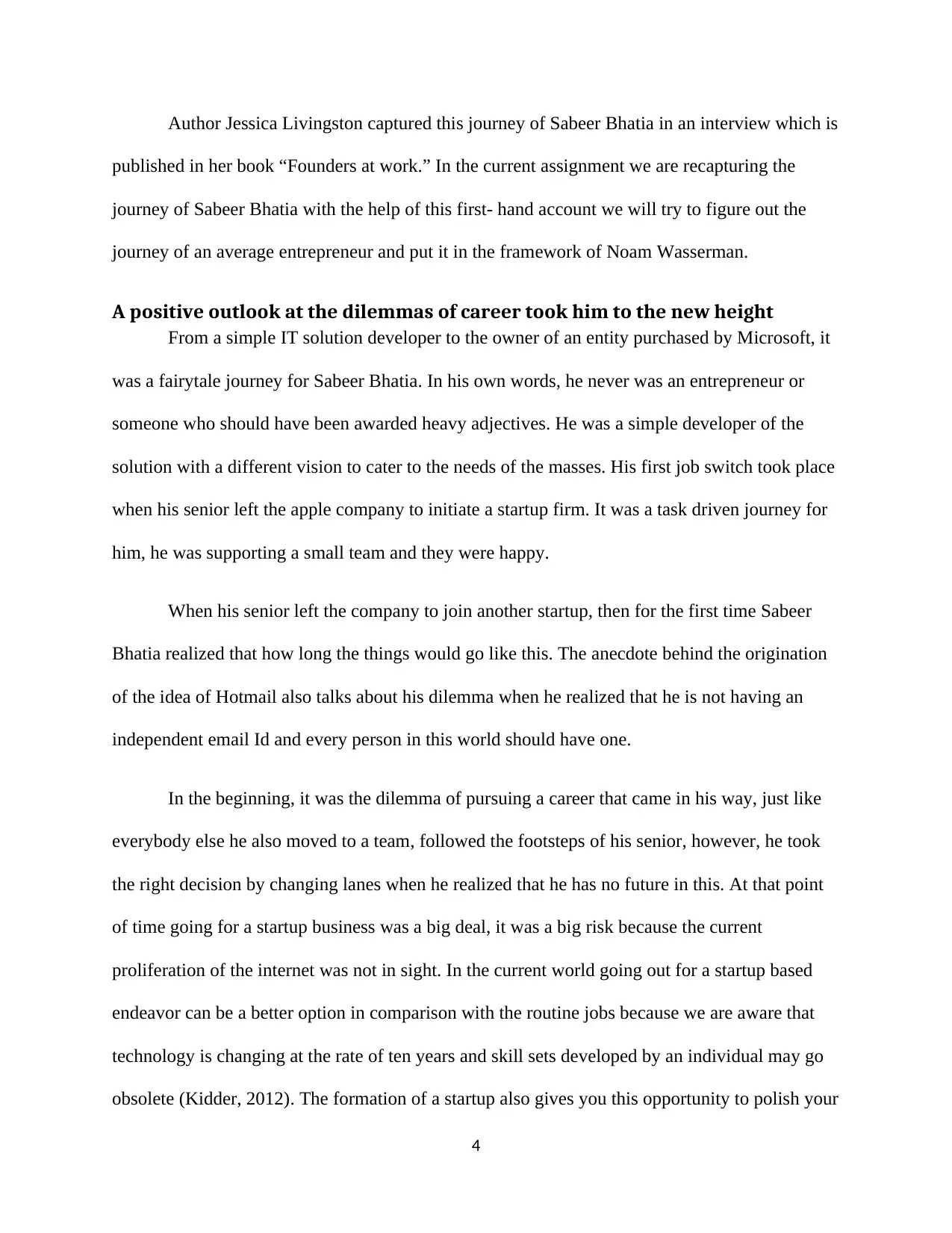
Author Jessica Livingston captured this journey of Sabeer Bhatia in an interview which is
published in her book “Founders at work.” In the current assignment we are recapturing the
journey of Sabeer Bhatia with the help of this first- hand account we will try to figure out the
journey of an average entrepreneur and put it in the framework of Noam Wasserman.
A positive outlook at the dilemmas of career took him to the new height
From a simple IT solution developer to the owner of an entity purchased by Microsoft, it
was a fairytale journey for Sabeer Bhatia. In his own words, he never was an entrepreneur or
someone who should have been awarded heavy adjectives. He was a simple developer of the
solution with a different vision to cater to the needs of the masses. His first job switch took place
when his senior left the apple company to initiate a startup firm. It was a task driven journey for
him, he was supporting a small team and they were happy.
When his senior left the company to join another startup, then for the first time Sabeer
Bhatia realized that how long the things would go like this. The anecdote behind the origination
of the idea of Hotmail also talks about his dilemma when he realized that he is not having an
independent email Id and every person in this world should have one.
In the beginning, it was the dilemma of pursuing a career that came in his way, just like
everybody else he also moved to a team, followed the footsteps of his senior, however, he took
the right decision by changing lanes when he realized that he has no future in this. At that point
of time going for a startup business was a big deal, it was a big risk because the current
proliferation of the internet was not in sight. In the current world going out for a startup based
endeavor can be a better option in comparison with the routine jobs because we are aware that
technology is changing at the rate of ten years and skill sets developed by an individual may go
obsolete (Kidder, 2012). The formation of a startup also gives you this opportunity to polish your
4
published in her book “Founders at work.” In the current assignment we are recapturing the
journey of Sabeer Bhatia with the help of this first- hand account we will try to figure out the
journey of an average entrepreneur and put it in the framework of Noam Wasserman.
A positive outlook at the dilemmas of career took him to the new height
From a simple IT solution developer to the owner of an entity purchased by Microsoft, it
was a fairytale journey for Sabeer Bhatia. In his own words, he never was an entrepreneur or
someone who should have been awarded heavy adjectives. He was a simple developer of the
solution with a different vision to cater to the needs of the masses. His first job switch took place
when his senior left the apple company to initiate a startup firm. It was a task driven journey for
him, he was supporting a small team and they were happy.
When his senior left the company to join another startup, then for the first time Sabeer
Bhatia realized that how long the things would go like this. The anecdote behind the origination
of the idea of Hotmail also talks about his dilemma when he realized that he is not having an
independent email Id and every person in this world should have one.
In the beginning, it was the dilemma of pursuing a career that came in his way, just like
everybody else he also moved to a team, followed the footsteps of his senior, however, he took
the right decision by changing lanes when he realized that he has no future in this. At that point
of time going for a startup business was a big deal, it was a big risk because the current
proliferation of the internet was not in sight. In the current world going out for a startup based
endeavor can be a better option in comparison with the routine jobs because we are aware that
technology is changing at the rate of ten years and skill sets developed by an individual may go
obsolete (Kidder, 2012). The formation of a startup also gives you this opportunity to polish your
4
Paraphrase This Document
Need a fresh take? Get an instant paraphrase of this document with our AI Paraphraser
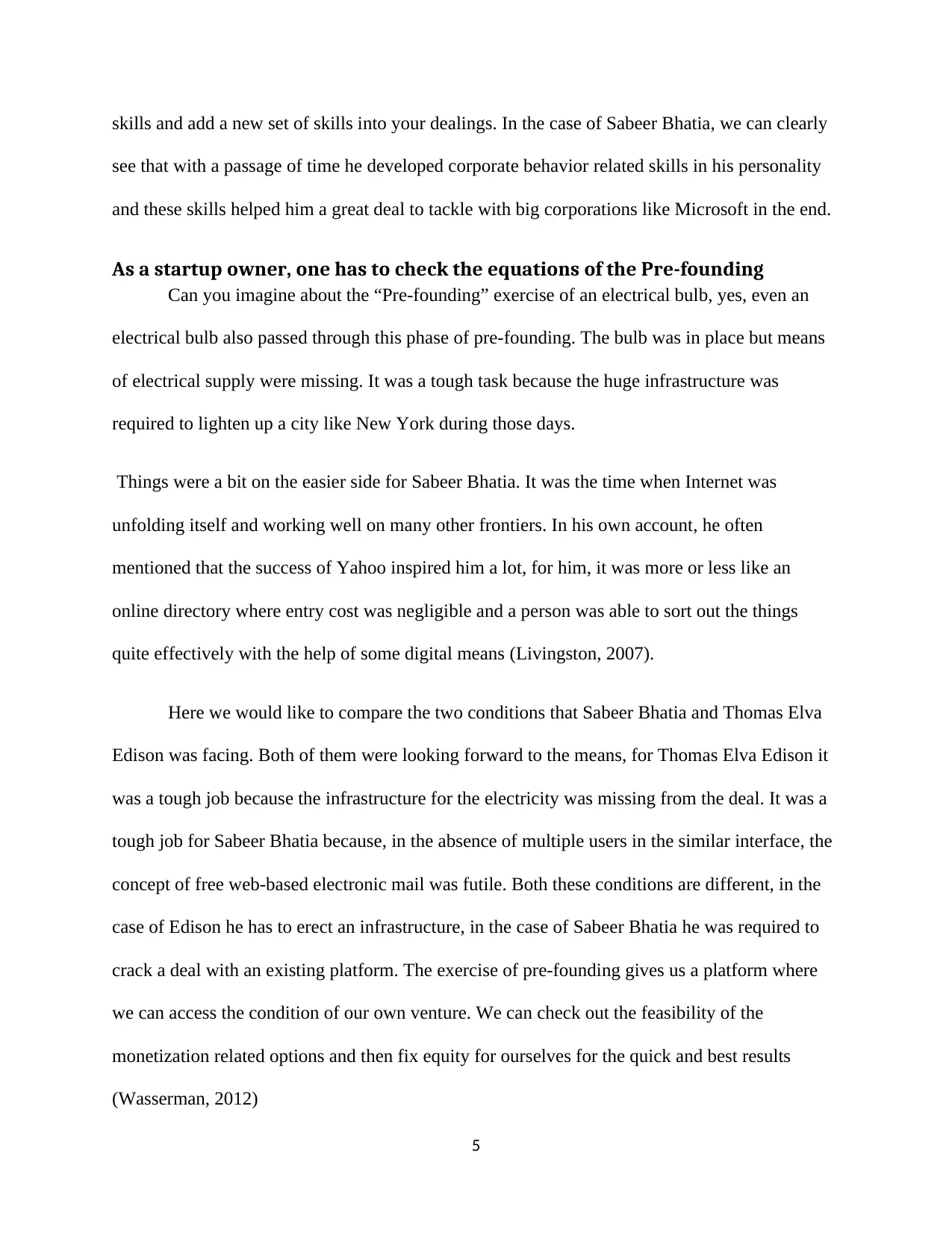
skills and add a new set of skills into your dealings. In the case of Sabeer Bhatia, we can clearly
see that with a passage of time he developed corporate behavior related skills in his personality
and these skills helped him a great deal to tackle with big corporations like Microsoft in the end.
As a startup owner, one has to check the equations of the Pre-founding
Can you imagine about the “Pre-founding” exercise of an electrical bulb, yes, even an
electrical bulb also passed through this phase of pre-founding. The bulb was in place but means
of electrical supply were missing. It was a tough task because the huge infrastructure was
required to lighten up a city like New York during those days.
Things were a bit on the easier side for Sabeer Bhatia. It was the time when Internet was
unfolding itself and working well on many other frontiers. In his own account, he often
mentioned that the success of Yahoo inspired him a lot, for him, it was more or less like an
online directory where entry cost was negligible and a person was able to sort out the things
quite effectively with the help of some digital means (Livingston, 2007).
Here we would like to compare the two conditions that Sabeer Bhatia and Thomas Elva
Edison was facing. Both of them were looking forward to the means, for Thomas Elva Edison it
was a tough job because the infrastructure for the electricity was missing from the deal. It was a
tough job for Sabeer Bhatia because, in the absence of multiple users in the similar interface, the
concept of free web-based electronic mail was futile. Both these conditions are different, in the
case of Edison he has to erect an infrastructure, in the case of Sabeer Bhatia he was required to
crack a deal with an existing platform. The exercise of pre-founding gives us a platform where
we can access the condition of our own venture. We can check out the feasibility of the
monetization related options and then fix equity for ourselves for the quick and best results
(Wasserman, 2012)
5
see that with a passage of time he developed corporate behavior related skills in his personality
and these skills helped him a great deal to tackle with big corporations like Microsoft in the end.
As a startup owner, one has to check the equations of the Pre-founding
Can you imagine about the “Pre-founding” exercise of an electrical bulb, yes, even an
electrical bulb also passed through this phase of pre-founding. The bulb was in place but means
of electrical supply were missing. It was a tough task because the huge infrastructure was
required to lighten up a city like New York during those days.
Things were a bit on the easier side for Sabeer Bhatia. It was the time when Internet was
unfolding itself and working well on many other frontiers. In his own account, he often
mentioned that the success of Yahoo inspired him a lot, for him, it was more or less like an
online directory where entry cost was negligible and a person was able to sort out the things
quite effectively with the help of some digital means (Livingston, 2007).
Here we would like to compare the two conditions that Sabeer Bhatia and Thomas Elva
Edison was facing. Both of them were looking forward to the means, for Thomas Elva Edison it
was a tough job because the infrastructure for the electricity was missing from the deal. It was a
tough job for Sabeer Bhatia because, in the absence of multiple users in the similar interface, the
concept of free web-based electronic mail was futile. Both these conditions are different, in the
case of Edison he has to erect an infrastructure, in the case of Sabeer Bhatia he was required to
crack a deal with an existing platform. The exercise of pre-founding gives us a platform where
we can access the condition of our own venture. We can check out the feasibility of the
monetization related options and then fix equity for ourselves for the quick and best results
(Wasserman, 2012)
5
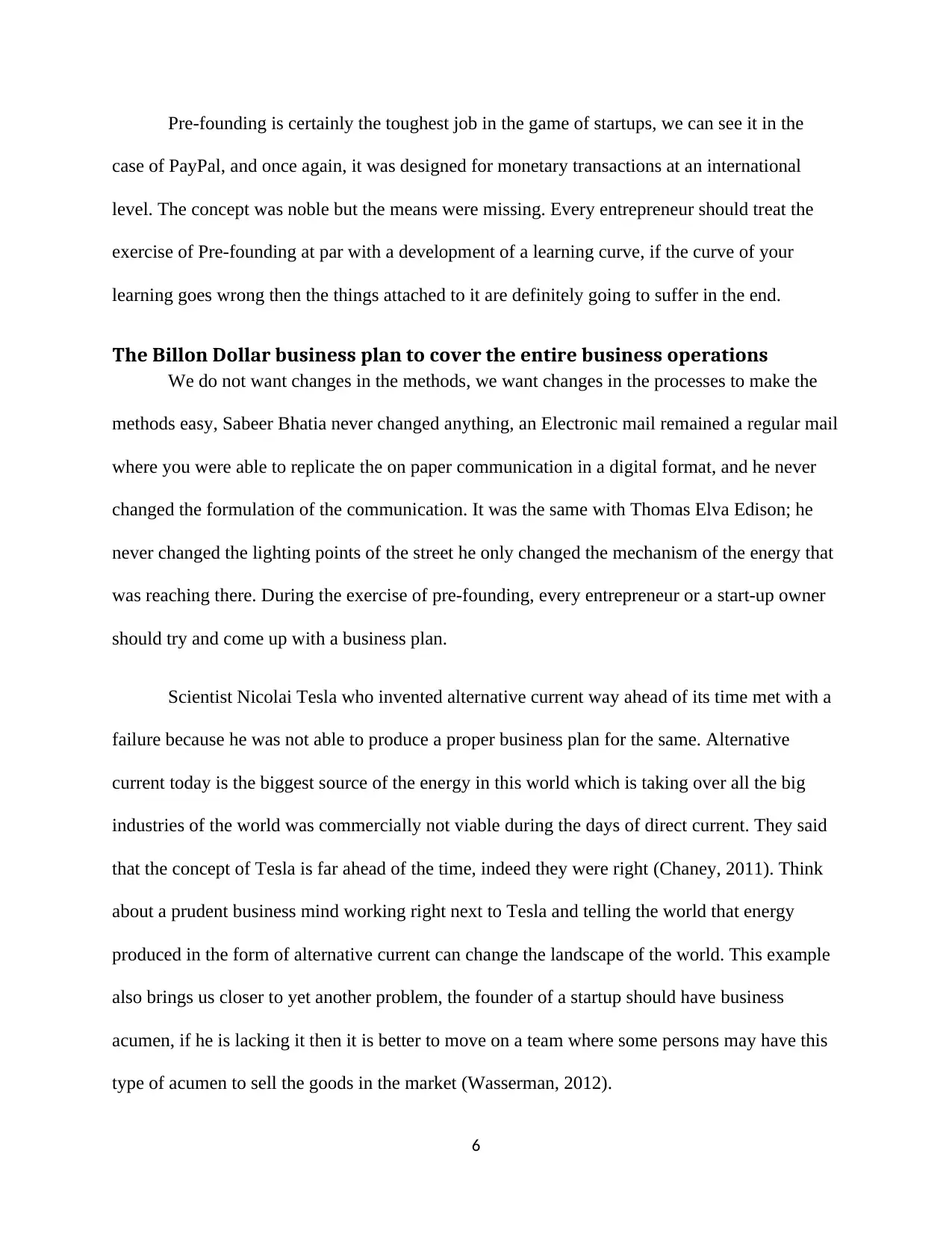
Pre-founding is certainly the toughest job in the game of startups, we can see it in the
case of PayPal, and once again, it was designed for monetary transactions at an international
level. The concept was noble but the means were missing. Every entrepreneur should treat the
exercise of Pre-founding at par with a development of a learning curve, if the curve of your
learning goes wrong then the things attached to it are definitely going to suffer in the end.
The Billon Dollar business plan to cover the entire business operations
We do not want changes in the methods, we want changes in the processes to make the
methods easy, Sabeer Bhatia never changed anything, an Electronic mail remained a regular mail
where you were able to replicate the on paper communication in a digital format, and he never
changed the formulation of the communication. It was the same with Thomas Elva Edison; he
never changed the lighting points of the street he only changed the mechanism of the energy that
was reaching there. During the exercise of pre-founding, every entrepreneur or a start-up owner
should try and come up with a business plan.
Scientist Nicolai Tesla who invented alternative current way ahead of its time met with a
failure because he was not able to produce a proper business plan for the same. Alternative
current today is the biggest source of the energy in this world which is taking over all the big
industries of the world was commercially not viable during the days of direct current. They said
that the concept of Tesla is far ahead of the time, indeed they were right (Chaney, 2011). Think
about a prudent business mind working right next to Tesla and telling the world that energy
produced in the form of alternative current can change the landscape of the world. This example
also brings us closer to yet another problem, the founder of a startup should have business
acumen, if he is lacking it then it is better to move on a team where some persons may have this
type of acumen to sell the goods in the market (Wasserman, 2012).
6
case of PayPal, and once again, it was designed for monetary transactions at an international
level. The concept was noble but the means were missing. Every entrepreneur should treat the
exercise of Pre-founding at par with a development of a learning curve, if the curve of your
learning goes wrong then the things attached to it are definitely going to suffer in the end.
The Billon Dollar business plan to cover the entire business operations
We do not want changes in the methods, we want changes in the processes to make the
methods easy, Sabeer Bhatia never changed anything, an Electronic mail remained a regular mail
where you were able to replicate the on paper communication in a digital format, and he never
changed the formulation of the communication. It was the same with Thomas Elva Edison; he
never changed the lighting points of the street he only changed the mechanism of the energy that
was reaching there. During the exercise of pre-founding, every entrepreneur or a start-up owner
should try and come up with a business plan.
Scientist Nicolai Tesla who invented alternative current way ahead of its time met with a
failure because he was not able to produce a proper business plan for the same. Alternative
current today is the biggest source of the energy in this world which is taking over all the big
industries of the world was commercially not viable during the days of direct current. They said
that the concept of Tesla is far ahead of the time, indeed they were right (Chaney, 2011). Think
about a prudent business mind working right next to Tesla and telling the world that energy
produced in the form of alternative current can change the landscape of the world. This example
also brings us closer to yet another problem, the founder of a startup should have business
acumen, if he is lacking it then it is better to move on a team where some persons may have this
type of acumen to sell the goods in the market (Wasserman, 2012).
6
⊘ This is a preview!⊘
Do you want full access?
Subscribe today to unlock all pages.

Trusted by 1+ million students worldwide
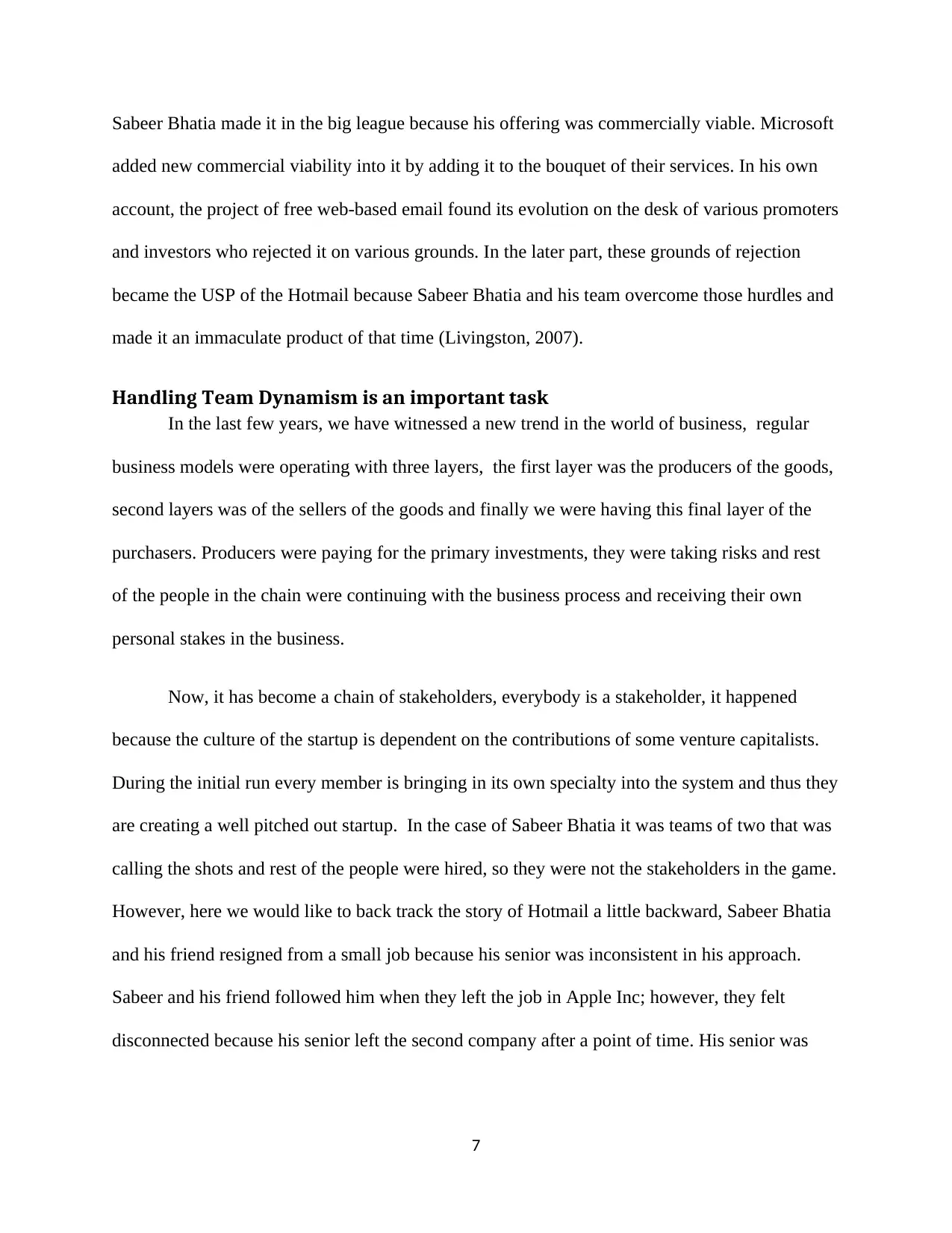
Sabeer Bhatia made it in the big league because his offering was commercially viable. Microsoft
added new commercial viability into it by adding it to the bouquet of their services. In his own
account, the project of free web-based email found its evolution on the desk of various promoters
and investors who rejected it on various grounds. In the later part, these grounds of rejection
became the USP of the Hotmail because Sabeer Bhatia and his team overcome those hurdles and
made it an immaculate product of that time (Livingston, 2007).
Handling Team Dynamism is an important task
In the last few years, we have witnessed a new trend in the world of business, regular
business models were operating with three layers, the first layer was the producers of the goods,
second layers was of the sellers of the goods and finally we were having this final layer of the
purchasers. Producers were paying for the primary investments, they were taking risks and rest
of the people in the chain were continuing with the business process and receiving their own
personal stakes in the business.
Now, it has become a chain of stakeholders, everybody is a stakeholder, it happened
because the culture of the startup is dependent on the contributions of some venture capitalists.
During the initial run every member is bringing in its own specialty into the system and thus they
are creating a well pitched out startup. In the case of Sabeer Bhatia it was teams of two that was
calling the shots and rest of the people were hired, so they were not the stakeholders in the game.
However, here we would like to back track the story of Hotmail a little backward, Sabeer Bhatia
and his friend resigned from a small job because his senior was inconsistent in his approach.
Sabeer and his friend followed him when they left the job in Apple Inc; however, they felt
disconnected because his senior left the second company after a point of time. His senior was
7
added new commercial viability into it by adding it to the bouquet of their services. In his own
account, the project of free web-based email found its evolution on the desk of various promoters
and investors who rejected it on various grounds. In the later part, these grounds of rejection
became the USP of the Hotmail because Sabeer Bhatia and his team overcome those hurdles and
made it an immaculate product of that time (Livingston, 2007).
Handling Team Dynamism is an important task
In the last few years, we have witnessed a new trend in the world of business, regular
business models were operating with three layers, the first layer was the producers of the goods,
second layers was of the sellers of the goods and finally we were having this final layer of the
purchasers. Producers were paying for the primary investments, they were taking risks and rest
of the people in the chain were continuing with the business process and receiving their own
personal stakes in the business.
Now, it has become a chain of stakeholders, everybody is a stakeholder, it happened
because the culture of the startup is dependent on the contributions of some venture capitalists.
During the initial run every member is bringing in its own specialty into the system and thus they
are creating a well pitched out startup. In the case of Sabeer Bhatia it was teams of two that was
calling the shots and rest of the people were hired, so they were not the stakeholders in the game.
However, here we would like to back track the story of Hotmail a little backward, Sabeer Bhatia
and his friend resigned from a small job because his senior was inconsistent in his approach.
Sabeer and his friend followed him when they left the job in Apple Inc; however, they felt
disconnected because his senior left the second company after a point of time. His senior was
7
Paraphrase This Document
Need a fresh take? Get an instant paraphrase of this document with our AI Paraphraser
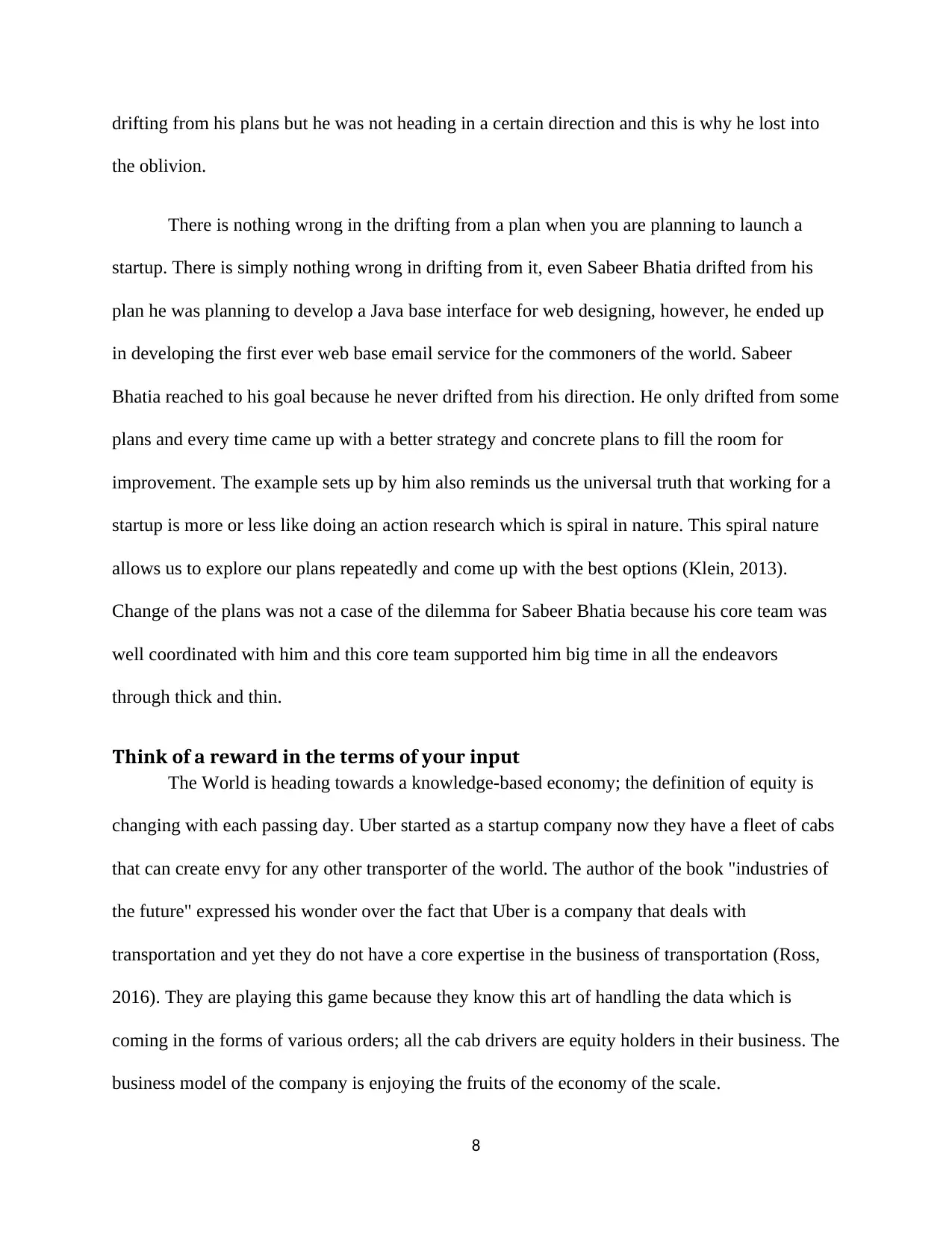
drifting from his plans but he was not heading in a certain direction and this is why he lost into
the oblivion.
There is nothing wrong in the drifting from a plan when you are planning to launch a
startup. There is simply nothing wrong in drifting from it, even Sabeer Bhatia drifted from his
plan he was planning to develop a Java base interface for web designing, however, he ended up
in developing the first ever web base email service for the commoners of the world. Sabeer
Bhatia reached to his goal because he never drifted from his direction. He only drifted from some
plans and every time came up with a better strategy and concrete plans to fill the room for
improvement. The example sets up by him also reminds us the universal truth that working for a
startup is more or less like doing an action research which is spiral in nature. This spiral nature
allows us to explore our plans repeatedly and come up with the best options (Klein, 2013).
Change of the plans was not a case of the dilemma for Sabeer Bhatia because his core team was
well coordinated with him and this core team supported him big time in all the endeavors
through thick and thin.
Think of a reward in the terms of your input
The World is heading towards a knowledge-based economy; the definition of equity is
changing with each passing day. Uber started as a startup company now they have a fleet of cabs
that can create envy for any other transporter of the world. The author of the book "industries of
the future" expressed his wonder over the fact that Uber is a company that deals with
transportation and yet they do not have a core expertise in the business of transportation (Ross,
2016). They are playing this game because they know this art of handling the data which is
coming in the forms of various orders; all the cab drivers are equity holders in their business. The
business model of the company is enjoying the fruits of the economy of the scale.
8
the oblivion.
There is nothing wrong in the drifting from a plan when you are planning to launch a
startup. There is simply nothing wrong in drifting from it, even Sabeer Bhatia drifted from his
plan he was planning to develop a Java base interface for web designing, however, he ended up
in developing the first ever web base email service for the commoners of the world. Sabeer
Bhatia reached to his goal because he never drifted from his direction. He only drifted from some
plans and every time came up with a better strategy and concrete plans to fill the room for
improvement. The example sets up by him also reminds us the universal truth that working for a
startup is more or less like doing an action research which is spiral in nature. This spiral nature
allows us to explore our plans repeatedly and come up with the best options (Klein, 2013).
Change of the plans was not a case of the dilemma for Sabeer Bhatia because his core team was
well coordinated with him and this core team supported him big time in all the endeavors
through thick and thin.
Think of a reward in the terms of your input
The World is heading towards a knowledge-based economy; the definition of equity is
changing with each passing day. Uber started as a startup company now they have a fleet of cabs
that can create envy for any other transporter of the world. The author of the book "industries of
the future" expressed his wonder over the fact that Uber is a company that deals with
transportation and yet they do not have a core expertise in the business of transportation (Ross,
2016). They are playing this game because they know this art of handling the data which is
coming in the forms of various orders; all the cab drivers are equity holders in their business. The
business model of the company is enjoying the fruits of the economy of the scale.
8
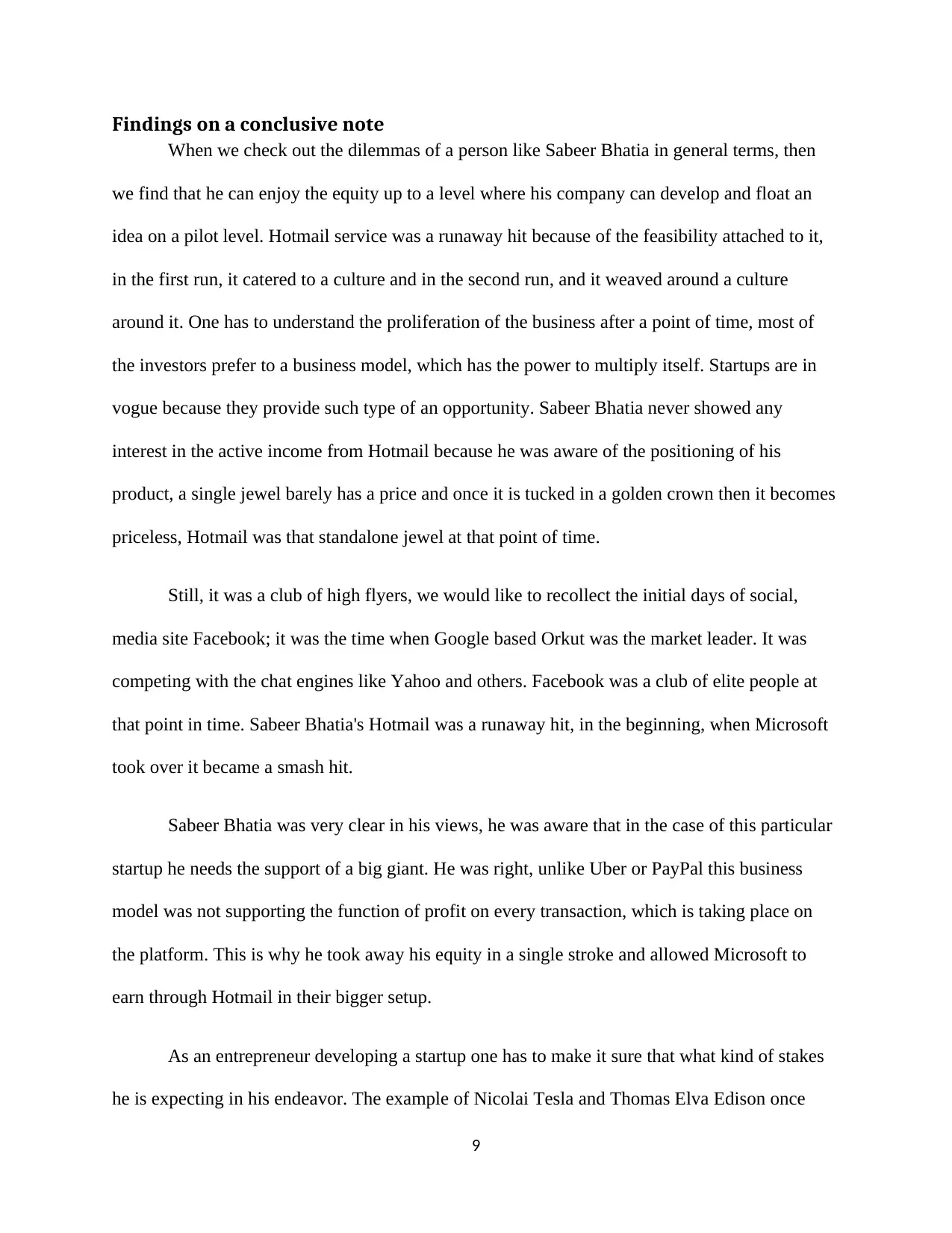
Findings on a conclusive note
When we check out the dilemmas of a person like Sabeer Bhatia in general terms, then
we find that he can enjoy the equity up to a level where his company can develop and float an
idea on a pilot level. Hotmail service was a runaway hit because of the feasibility attached to it,
in the first run, it catered to a culture and in the second run, and it weaved around a culture
around it. One has to understand the proliferation of the business after a point of time, most of
the investors prefer to a business model, which has the power to multiply itself. Startups are in
vogue because they provide such type of an opportunity. Sabeer Bhatia never showed any
interest in the active income from Hotmail because he was aware of the positioning of his
product, a single jewel barely has a price and once it is tucked in a golden crown then it becomes
priceless, Hotmail was that standalone jewel at that point of time.
Still, it was a club of high flyers, we would like to recollect the initial days of social,
media site Facebook; it was the time when Google based Orkut was the market leader. It was
competing with the chat engines like Yahoo and others. Facebook was a club of elite people at
that point in time. Sabeer Bhatia's Hotmail was a runaway hit, in the beginning, when Microsoft
took over it became a smash hit.
Sabeer Bhatia was very clear in his views, he was aware that in the case of this particular
startup he needs the support of a big giant. He was right, unlike Uber or PayPal this business
model was not supporting the function of profit on every transaction, which is taking place on
the platform. This is why he took away his equity in a single stroke and allowed Microsoft to
earn through Hotmail in their bigger setup.
As an entrepreneur developing a startup one has to make it sure that what kind of stakes
he is expecting in his endeavor. The example of Nicolai Tesla and Thomas Elva Edison once
9
When we check out the dilemmas of a person like Sabeer Bhatia in general terms, then
we find that he can enjoy the equity up to a level where his company can develop and float an
idea on a pilot level. Hotmail service was a runaway hit because of the feasibility attached to it,
in the first run, it catered to a culture and in the second run, and it weaved around a culture
around it. One has to understand the proliferation of the business after a point of time, most of
the investors prefer to a business model, which has the power to multiply itself. Startups are in
vogue because they provide such type of an opportunity. Sabeer Bhatia never showed any
interest in the active income from Hotmail because he was aware of the positioning of his
product, a single jewel barely has a price and once it is tucked in a golden crown then it becomes
priceless, Hotmail was that standalone jewel at that point of time.
Still, it was a club of high flyers, we would like to recollect the initial days of social,
media site Facebook; it was the time when Google based Orkut was the market leader. It was
competing with the chat engines like Yahoo and others. Facebook was a club of elite people at
that point in time. Sabeer Bhatia's Hotmail was a runaway hit, in the beginning, when Microsoft
took over it became a smash hit.
Sabeer Bhatia was very clear in his views, he was aware that in the case of this particular
startup he needs the support of a big giant. He was right, unlike Uber or PayPal this business
model was not supporting the function of profit on every transaction, which is taking place on
the platform. This is why he took away his equity in a single stroke and allowed Microsoft to
earn through Hotmail in their bigger setup.
As an entrepreneur developing a startup one has to make it sure that what kind of stakes
he is expecting in his endeavor. The example of Nicolai Tesla and Thomas Elva Edison once
9
⊘ This is a preview!⊘
Do you want full access?
Subscribe today to unlock all pages.

Trusted by 1+ million students worldwide
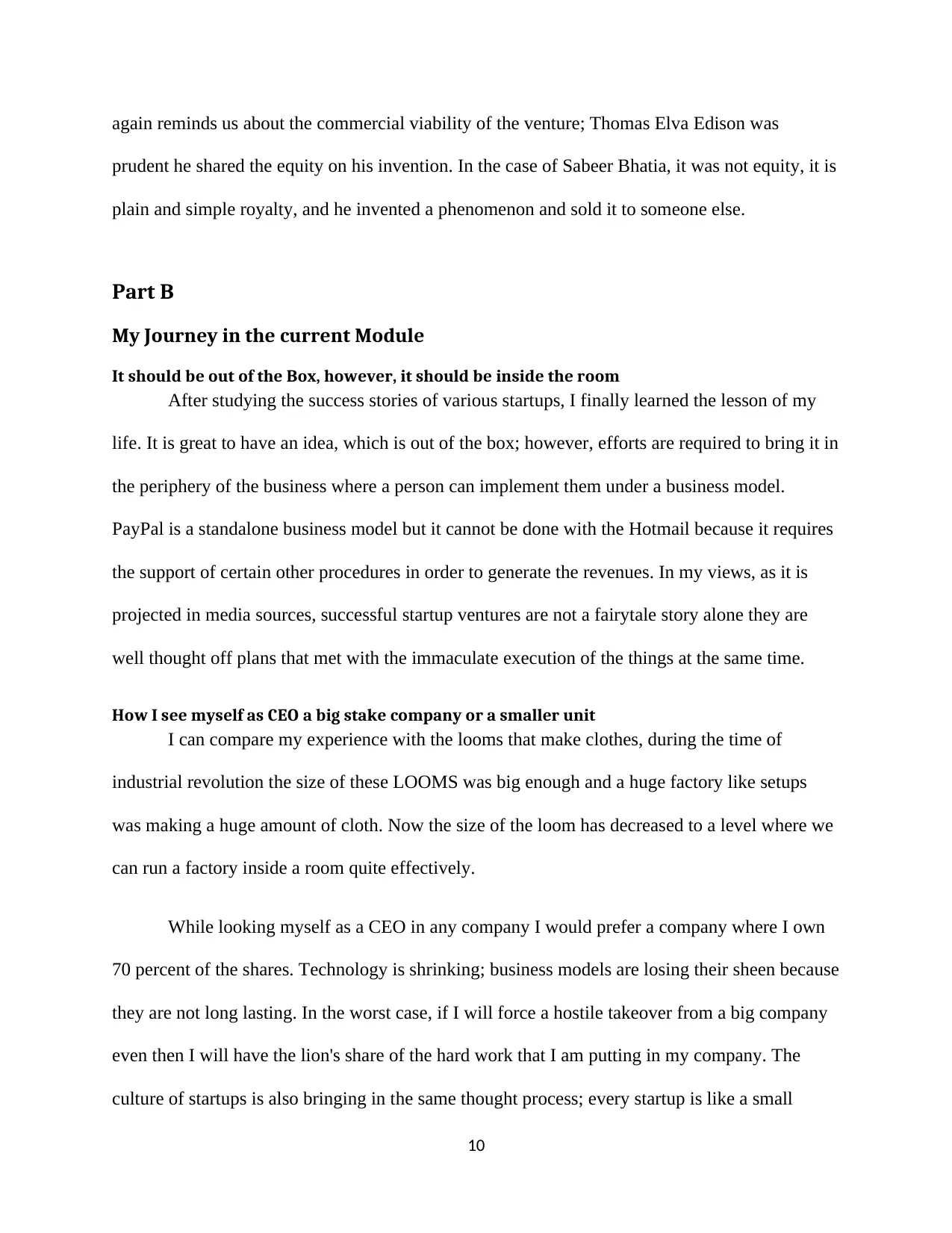
again reminds us about the commercial viability of the venture; Thomas Elva Edison was
prudent he shared the equity on his invention. In the case of Sabeer Bhatia, it was not equity, it is
plain and simple royalty, and he invented a phenomenon and sold it to someone else.
Part B
My Journey in the current Module
It should be out of the Box, however, it should be inside the room
After studying the success stories of various startups, I finally learned the lesson of my
life. It is great to have an idea, which is out of the box; however, efforts are required to bring it in
the periphery of the business where a person can implement them under a business model.
PayPal is a standalone business model but it cannot be done with the Hotmail because it requires
the support of certain other procedures in order to generate the revenues. In my views, as it is
projected in media sources, successful startup ventures are not a fairytale story alone they are
well thought off plans that met with the immaculate execution of the things at the same time.
How I see myself as CEO a big stake company or a smaller unit
I can compare my experience with the looms that make clothes, during the time of
industrial revolution the size of these LOOMS was big enough and a huge factory like setups
was making a huge amount of cloth. Now the size of the loom has decreased to a level where we
can run a factory inside a room quite effectively.
While looking myself as a CEO in any company I would prefer a company where I own
70 percent of the shares. Technology is shrinking; business models are losing their sheen because
they are not long lasting. In the worst case, if I will force a hostile takeover from a big company
even then I will have the lion's share of the hard work that I am putting in my company. The
culture of startups is also bringing in the same thought process; every startup is like a small
10
prudent he shared the equity on his invention. In the case of Sabeer Bhatia, it was not equity, it is
plain and simple royalty, and he invented a phenomenon and sold it to someone else.
Part B
My Journey in the current Module
It should be out of the Box, however, it should be inside the room
After studying the success stories of various startups, I finally learned the lesson of my
life. It is great to have an idea, which is out of the box; however, efforts are required to bring it in
the periphery of the business where a person can implement them under a business model.
PayPal is a standalone business model but it cannot be done with the Hotmail because it requires
the support of certain other procedures in order to generate the revenues. In my views, as it is
projected in media sources, successful startup ventures are not a fairytale story alone they are
well thought off plans that met with the immaculate execution of the things at the same time.
How I see myself as CEO a big stake company or a smaller unit
I can compare my experience with the looms that make clothes, during the time of
industrial revolution the size of these LOOMS was big enough and a huge factory like setups
was making a huge amount of cloth. Now the size of the loom has decreased to a level where we
can run a factory inside a room quite effectively.
While looking myself as a CEO in any company I would prefer a company where I own
70 percent of the shares. Technology is shrinking; business models are losing their sheen because
they are not long lasting. In the worst case, if I will force a hostile takeover from a big company
even then I will have the lion's share of the hard work that I am putting in my company. The
culture of startups is also bringing in the same thought process; every startup is like a small
10
Paraphrase This Document
Need a fresh take? Get an instant paraphrase of this document with our AI Paraphraser
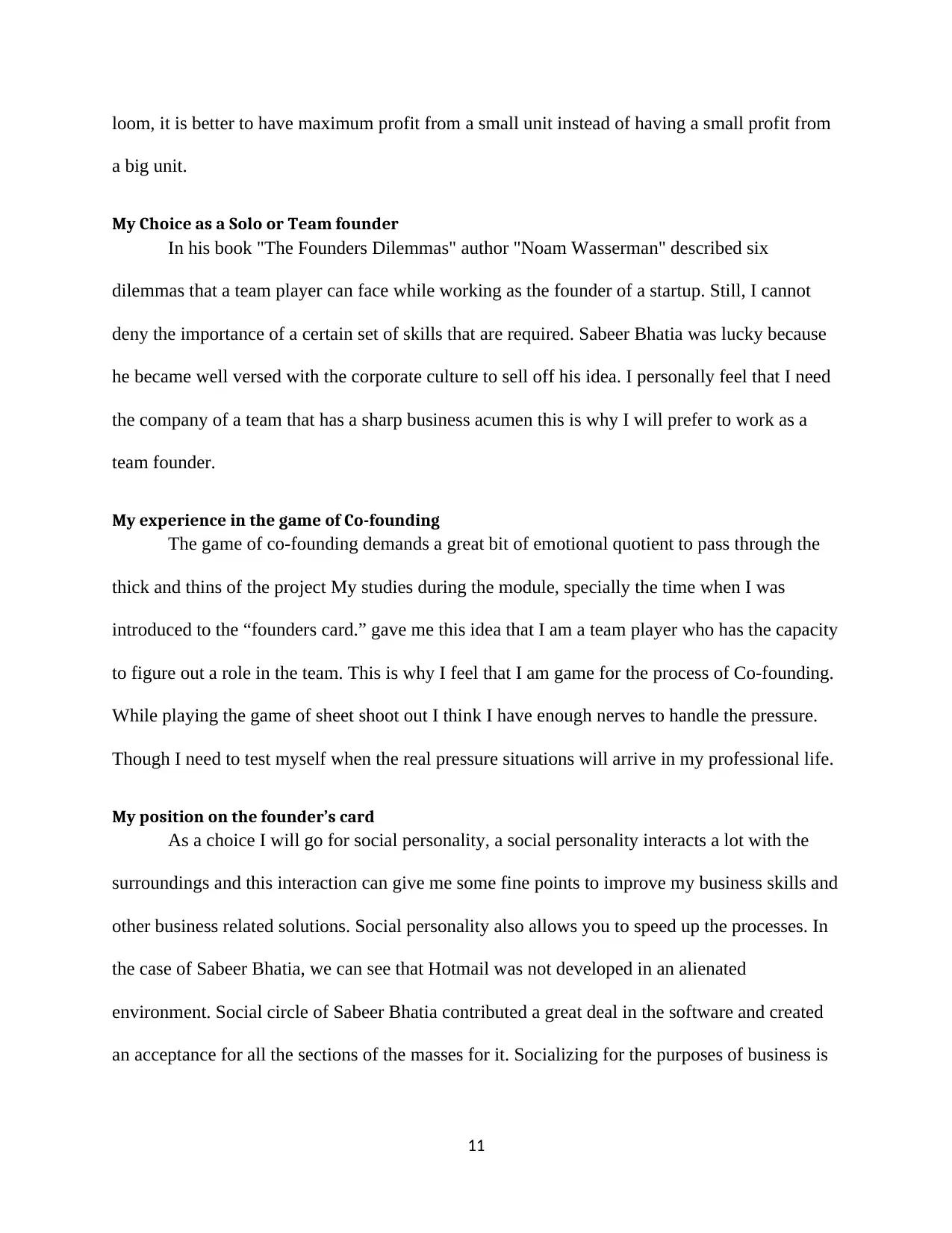
loom, it is better to have maximum profit from a small unit instead of having a small profit from
a big unit.
My Choice as a Solo or Team founder
In his book "The Founders Dilemmas" author "Noam Wasserman" described six
dilemmas that a team player can face while working as the founder of a startup. Still, I cannot
deny the importance of a certain set of skills that are required. Sabeer Bhatia was lucky because
he became well versed with the corporate culture to sell off his idea. I personally feel that I need
the company of a team that has a sharp business acumen this is why I will prefer to work as a
team founder.
My experience in the game of Co-founding
The game of co-founding demands a great bit of emotional quotient to pass through the
thick and thins of the project My studies during the module, specially the time when I was
introduced to the “founders card.” gave me this idea that I am a team player who has the capacity
to figure out a role in the team. This is why I feel that I am game for the process of Co-founding.
While playing the game of sheet shoot out I think I have enough nerves to handle the pressure.
Though I need to test myself when the real pressure situations will arrive in my professional life.
My position on the founder’s card
As a choice I will go for social personality, a social personality interacts a lot with the
surroundings and this interaction can give me some fine points to improve my business skills and
other business related solutions. Social personality also allows you to speed up the processes. In
the case of Sabeer Bhatia, we can see that Hotmail was not developed in an alienated
environment. Social circle of Sabeer Bhatia contributed a great deal in the software and created
an acceptance for all the sections of the masses for it. Socializing for the purposes of business is
11
a big unit.
My Choice as a Solo or Team founder
In his book "The Founders Dilemmas" author "Noam Wasserman" described six
dilemmas that a team player can face while working as the founder of a startup. Still, I cannot
deny the importance of a certain set of skills that are required. Sabeer Bhatia was lucky because
he became well versed with the corporate culture to sell off his idea. I personally feel that I need
the company of a team that has a sharp business acumen this is why I will prefer to work as a
team founder.
My experience in the game of Co-founding
The game of co-founding demands a great bit of emotional quotient to pass through the
thick and thins of the project My studies during the module, specially the time when I was
introduced to the “founders card.” gave me this idea that I am a team player who has the capacity
to figure out a role in the team. This is why I feel that I am game for the process of Co-founding.
While playing the game of sheet shoot out I think I have enough nerves to handle the pressure.
Though I need to test myself when the real pressure situations will arrive in my professional life.
My position on the founder’s card
As a choice I will go for social personality, a social personality interacts a lot with the
surroundings and this interaction can give me some fine points to improve my business skills and
other business related solutions. Social personality also allows you to speed up the processes. In
the case of Sabeer Bhatia, we can see that Hotmail was not developed in an alienated
environment. Social circle of Sabeer Bhatia contributed a great deal in the software and created
an acceptance for all the sections of the masses for it. Socializing for the purposes of business is
11
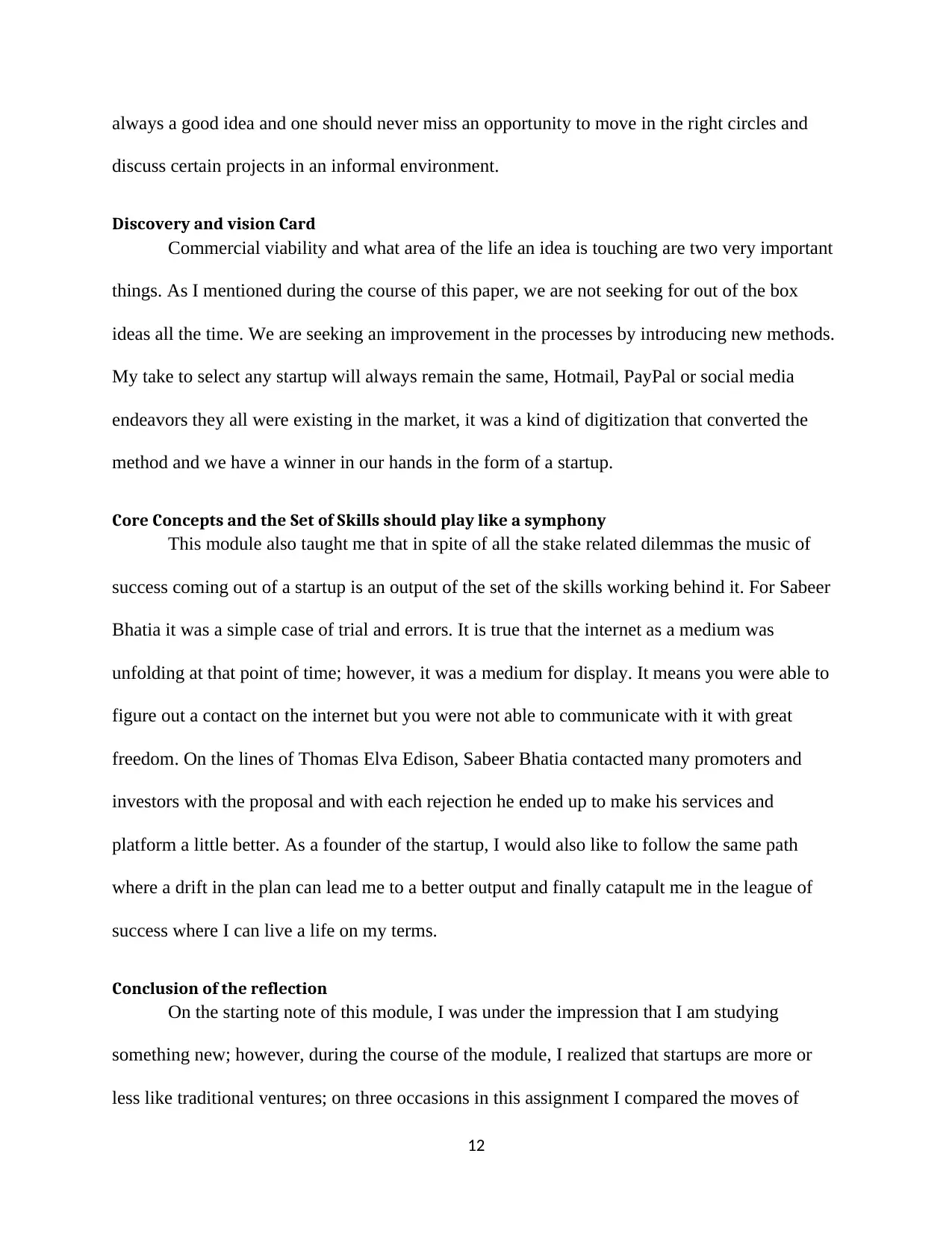
always a good idea and one should never miss an opportunity to move in the right circles and
discuss certain projects in an informal environment.
Discovery and vision Card
Commercial viability and what area of the life an idea is touching are two very important
things. As I mentioned during the course of this paper, we are not seeking for out of the box
ideas all the time. We are seeking an improvement in the processes by introducing new methods.
My take to select any startup will always remain the same, Hotmail, PayPal or social media
endeavors they all were existing in the market, it was a kind of digitization that converted the
method and we have a winner in our hands in the form of a startup.
Core Concepts and the Set of Skills should play like a symphony
This module also taught me that in spite of all the stake related dilemmas the music of
success coming out of a startup is an output of the set of the skills working behind it. For Sabeer
Bhatia it was a simple case of trial and errors. It is true that the internet as a medium was
unfolding at that point of time; however, it was a medium for display. It means you were able to
figure out a contact on the internet but you were not able to communicate with it with great
freedom. On the lines of Thomas Elva Edison, Sabeer Bhatia contacted many promoters and
investors with the proposal and with each rejection he ended up to make his services and
platform a little better. As a founder of the startup, I would also like to follow the same path
where a drift in the plan can lead me to a better output and finally catapult me in the league of
success where I can live a life on my terms.
Conclusion of the reflection
On the starting note of this module, I was under the impression that I am studying
something new; however, during the course of the module, I realized that startups are more or
less like traditional ventures; on three occasions in this assignment I compared the moves of
12
discuss certain projects in an informal environment.
Discovery and vision Card
Commercial viability and what area of the life an idea is touching are two very important
things. As I mentioned during the course of this paper, we are not seeking for out of the box
ideas all the time. We are seeking an improvement in the processes by introducing new methods.
My take to select any startup will always remain the same, Hotmail, PayPal or social media
endeavors they all were existing in the market, it was a kind of digitization that converted the
method and we have a winner in our hands in the form of a startup.
Core Concepts and the Set of Skills should play like a symphony
This module also taught me that in spite of all the stake related dilemmas the music of
success coming out of a startup is an output of the set of the skills working behind it. For Sabeer
Bhatia it was a simple case of trial and errors. It is true that the internet as a medium was
unfolding at that point of time; however, it was a medium for display. It means you were able to
figure out a contact on the internet but you were not able to communicate with it with great
freedom. On the lines of Thomas Elva Edison, Sabeer Bhatia contacted many promoters and
investors with the proposal and with each rejection he ended up to make his services and
platform a little better. As a founder of the startup, I would also like to follow the same path
where a drift in the plan can lead me to a better output and finally catapult me in the league of
success where I can live a life on my terms.
Conclusion of the reflection
On the starting note of this module, I was under the impression that I am studying
something new; however, during the course of the module, I realized that startups are more or
less like traditional ventures; on three occasions in this assignment I compared the moves of
12
⊘ This is a preview!⊘
Do you want full access?
Subscribe today to unlock all pages.

Trusted by 1+ million students worldwide

Thomas Elva Edison with Sabeer Bhatia. Both belong to different era's still they were facing the
same set of challenges. It also gives me a lesson that history of great entrepreneurs is not
redundant anymore, only the terminology has changed a bit, the essence is still the same.
13
same set of challenges. It also gives me a lesson that history of great entrepreneurs is not
redundant anymore, only the terminology has changed a bit, the essence is still the same.
13
Paraphrase This Document
Need a fresh take? Get an instant paraphrase of this document with our AI Paraphraser
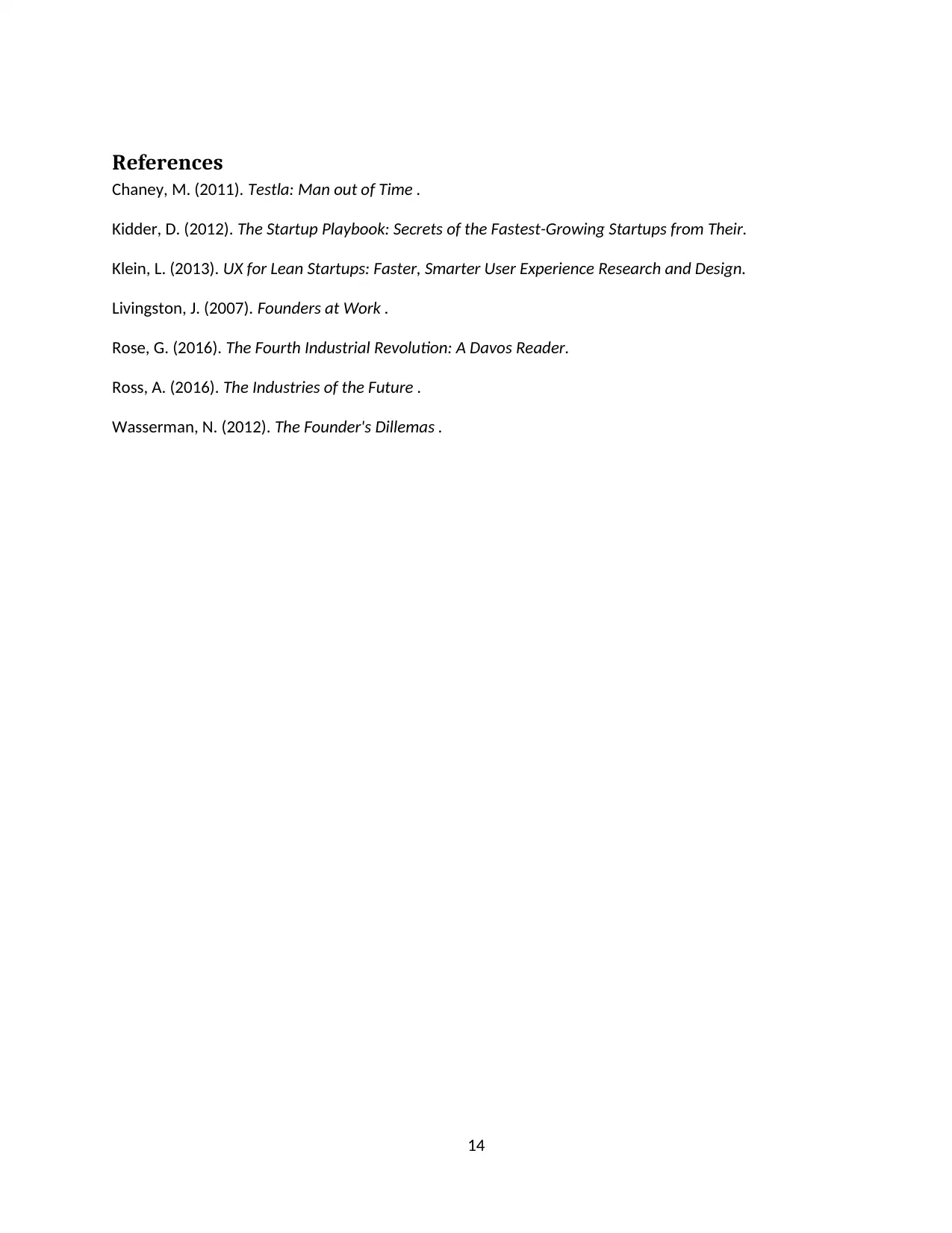
References
Chaney, M. (2011). Testla: Man out of Time .
Kidder, D. (2012). The Startup Playbook: Secrets of the Fastest-Growing Startups from Their.
Klein, L. (2013). UX for Lean Startups: Faster, Smarter User Experience Research and Design.
Livingston, J. (2007). Founders at Work .
Rose, G. (2016). The Fourth Industrial Revolution: A Davos Reader.
Ross, A. (2016). The Industries of the Future .
Wasserman, N. (2012). The Founder's Dillemas .
14
Chaney, M. (2011). Testla: Man out of Time .
Kidder, D. (2012). The Startup Playbook: Secrets of the Fastest-Growing Startups from Their.
Klein, L. (2013). UX for Lean Startups: Faster, Smarter User Experience Research and Design.
Livingston, J. (2007). Founders at Work .
Rose, G. (2016). The Fourth Industrial Revolution: A Davos Reader.
Ross, A. (2016). The Industries of the Future .
Wasserman, N. (2012). The Founder's Dillemas .
14
1 out of 14
Your All-in-One AI-Powered Toolkit for Academic Success.
+13062052269
info@desklib.com
Available 24*7 on WhatsApp / Email
![[object Object]](/_next/static/media/star-bottom.7253800d.svg)
Unlock your academic potential
© 2024 | Zucol Services PVT LTD | All rights reserved.